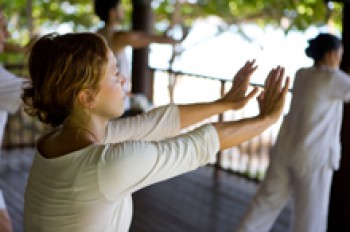Tai Chi Increases Balance in Parkinson’s Patients
Tai Chi Increases Balance in Parkinson’s Patients
People with Parkinson’s disease often have problems with balance and can suffer life-threatening falls. For patients with mild to moderate cases, a new study suggests that the ancient art of tai chi may significantly improve balance and reduce falls.

Exercise and mild resistance training have been shown to help patients with Parkinson’s disease retain motor function. However, these methods often require special trainers and equipment. A team of researchers led by Dr. Fuzhong Li of the Oregon Research Institute tested to see if tai chi might help. Tai chi is a style of exercise that emphasizes balance and strength. The study, funded by NIH’s National Institute of Neurological Disorders and Stroke (NINDS), appeared in the February 9, 2012, issue of the New England Journal of Medicine.
The researchers selected 195 patients with Parkinson’s disease who had some motor function deficits but were able to stand and walk independently. Participants were randomly assigned to 1 of 3 exercise programs: tai chi, resistance training or stretching. The tai chi program was designed to enhance balance and leaning strength. The resistance training program specifically strengthened upper and lower body muscles involved in balance. The stretching program preserved the social aspect and enjoyment of an exercise program without increasing muscle strength or balance.
The groups met for hour-long classes twice a week for 24 weeks. The researchers then evaluated the participants on several aspects of balance and physical outcomes, including leaning, directional control, leg strength, stride length and walking speed. They found that, compared to stretching, tai chi increased every measure of balance and strength. Tai chi also brought greater improvements in leaning, stride length and directional control than resistance training.
Based on reports by the participants, the tai chi group participants had 67% fewer falls than the stretching group during the 6 month study period. During the 3 months following the exercise program, the tai chi participants had significantly fewer falls than those in the other 2 groups. Thus, tai chi training may have long-lasting effects.
“These results are clinically significant because they suggest that tai chi, a low-to-moderate impact exercise, may be used, as an add-on to current physical therapies, to address some of the key clinical problems in Parkinson’s disease, such as postural and gait instability,” says Dr. Li. This low-cost, simple activity could help improve the lives and safety of many patients with mild-to-moderate Parkinson’s disease.
By Lesley Earl, Ph.D.
###
* The above story is reprinted from materials provided by National Institutes of Health (NIH)
** The National Institutes of Health (NIH) , a part of the U.S. Department of Health and Human Services, is the nation’s medical research agency—making important discoveries that improve health and save lives. The National Institutes of Health is made up of 27 different components called Institutes and Centers. Each has its own specific research agenda. All but three of these components receive their funding directly from Congress, and administrate their own budgets.




















